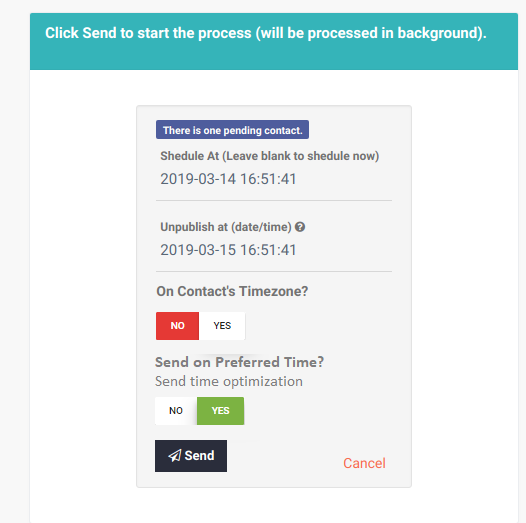Preferred Time or Send Time Optimization feature settings inside Aritic PinPoint, segment-based email campaigns, and automation campaigns, trigger the emails based on the past open behavior of the subscriber/ contact automatically. Since the email is delivered to the subscribers when they are most likely to open the email from their mailbox. This feature helps improve the email open rate drastically.
You can find this setting inside the segment-based email campaign before you finalize the email scheduling and other email delivery settings.

Note: “Contact’s Timezone Scheduling” and “Send at Preferred Time” should not work in parallel. Only one setting should work at a time.
How Scheduling on Contact’s Timezone Work?
If you have enabled “On Contact’s Timezone” then the email campaign will be sent according to the contact’s timezone time, rather than being sent immediately.
If you have selected a date and time from the Schedule option and have also enabled “On Contact’s Timezone” then the email campaign will be sent according to the contact’s timezone time and the scheduled time, rather than being sent immediately.
Note: If a contact doesn’t have a timezone defined inside their custom field, then, they will receive the email immediately or the time at which the email campaign has been scheduled.
How Send on Preferred Time or Send Time Optimization work?
If this setting is enabled, then you would not be able to enable the “On Contact’s Timezone” setting. And, this setting will send emails to the subscriber/contact from the segment at their own preferred open time.
How Preferred Time for Contact/ Subscriber is define?
Aritic PinPoint stores the time and date on which each contact opens any of the email templates sent to them from Aritic PinPoint. Based on these times of opening the emails within every 24 hours, Aritic PinPoint defines the optimistic email open time for each contact/ subscriber. And, based on the optimistic time, the next emails are delivered to the contact when “Send at Preferred Time” is enabled.
For example, if a contact had received 50 emails from Aritic PinPoint and he opened the majority of the emails between 9 AM and 10 AM in his timezone, then the next email sent to this contact will be between 9 AM and 10 AM in their timezone when “Send at Preferred Time” is enabled.
Based on the above settings, the following 8 cases of settings can be achieved:

Case-I: The contact/ subscriber will receive an email as defined from the “Schedule At” date and time.
Case-II: The contact/ subscriber will receive email based on their preferred optimal time after the scheduled date and time, as defined in the “Schedule At” setting.
Case-III: The contact/ subscriber will receive email based on their own time zone after the scheduled date and time, as defined in the “Schedule At” setting.
Case-IV: The contact/ subscriber will receive email based on their own time zone after the scheduled date and time, as defined in the “Schedule At” setting, and the contacts whose optimal time is known, will receive the email accordingly.
Case-V: The contact/ subscriber will receive email based on their own time zone, according to the time at which the campaign is being sent.
Case-VI: The contact/ subscriber will receive email based on their optimal preferred time and whose optimal preferred time is not known, they will receive the email immediately.
Case-VII: The contact/ subscriber will receive an email based on their own time zone after the campaign is sent and the contacts whose optimal time is known, will receive the email accordingly.
Case-VIII: The contact/ subscriber will receive an email immediately, as soon as the email campaign is sent.